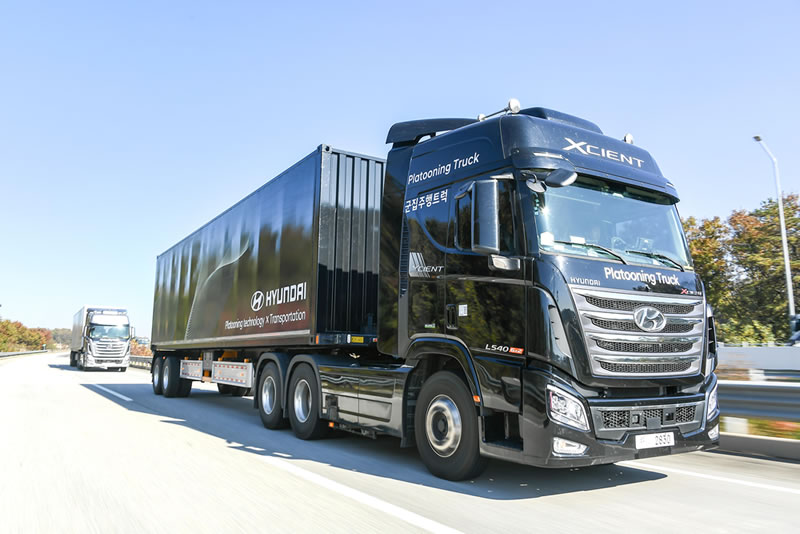Home » Trailer Industry » Trailer Industry News » Hyundai Conducts Truck Platooning Trial

Hyundai Motor Demonstrates Autonomous Driving Tech Capabilities with First Successful Truck Platooning Trial
- Demonstration showcases breakthroughs in commercial autonomous driving technology with V2V communication
- Part of the national demonstration project involving government, corporations and academia for leadership in autonomous technology
SEOUL – (Trailer Technician) — Hyundai Motor Company successfully conducted the company’s first platooning of trailer trucks on the Yeoju Smart Highway replicating real-world traffic conditions.
Hyundai Motor conducted the trial using two trailer-connected Xcient trucks.
Yeoju Smart Highway is a 7.7km testbed within the central region expressway established by the Korean government for the development of autonomous driving technology. The highway is constantly populated by vehicles for autonomous driving research, making it quite similar to the conditions of an actual highway.

The demonstration successfully displayed the following technology: Vehicle platooning, cut-in/out by other vehicles, simultaneous emergency braking, and V2V (Vehicle to Vehicle) communication tech. The speed limit was set at 60km/h to ensure safety.
“We are confident that our industry leading autonomous driving technology in commercial vehicles showcased in this platooning truck demonstration will lead into a revolutionary paradigm shift in the freight and logistics industry,” said Jihan Ryu, head of Hyundai Motor’s Commercial Vehicle Electronics Control Engineering Group. “We will strive to create constructive synergy by sharing our knowhow and experiences of developing autonomous driving technology between commercial vehicle and passenger vehicle sectors to expedite level-5 autonomous driving technology.”
This demonstration is part of a project initiated by the Ministry of Land, Infrastructure and Transport (MOLIT). Since 2018, MOLIT has been working to support pioneering efforts for autonomous technology. Along with Hyundai Motor Company, this national project involved government, corporations, and academia. Vehicle platooning has the benefit of reducing air resistance to improve fuel efficiency and lower emissions, making it an eco-friendly technology.
The platooning maneuver begins when the driver of the following truck approaches the leading vehicle and activates platooning mode.
Upon activation of platooning mode, the following truck maintains a 16.7m distance, with real-time fine tuning based on the leading vehicle’s acceleration and deceleration. The driver does not need to put his/her foot on the accelerator nor brakes, vastly reducing fatigue on the road and improving safety.
The mode also activates lane keeping technology which makes possible for the driver of following truck to take hands off the steering wheel.
With platooning, other vehicles cutting in and out between trucks can also be seamlessly managed. If a vehicle cuts between the platooning trucks, the following truck automatically extends the gap to minimum of 25m.
When a leading truck makes a sudden emergency stop due to an unexpected situation, the newly demonstrated technology responds by enabling the following truck to decelerate and stop.
The V2V system applied to both trucks in this demonstration showcased how real time information sharing between platooning vehicles can improve control over acceleration and deceleration, and also incorporate ADAS (Advanced Driver Assistance System) information from various sensors like cameras and radar.
Furthermore, the Real-time Frontal Video Sharing feature was enabled by V2V technology. By displaying videos from the leading vehicle, the following driver can see the road ahead, solving limitations of forward vision for trailing drivers.
Hyundai Motor will strive to achieve high-level platooning technology which will work under even tighter following distance between vehicles and also implement traffic information for optimized travel in the future.
In August 2018, Hyundai Motor, in partnership with Hyundai Glovis, completed South Korea’s first domestic highway journey with an autonomously navigated truck for approximately 40km on the highway between Uiwang and Incheon. The truck displayed SAE (Society of Automotive Engineers Standard) Level-3 autonomous driving.
The Hyundai Xcient is 40 ton truck sold across the globe. Hyundai is also spearheading eco-friendly movement in the commercial vehicles sector with the Xcient Fuel Cell truck unveiled last September. The company plans to deliver 1,600 vehicles to Switzerland by 2025.
About Hyundai Motor
Established in 1967, Hyundai Motor Company is committed to becoming a lifetime partner in automobiles and beyond with its range of world-class vehicles and mobility services available in more than 200 countries. Hyundai sold more than 4.5 million vehicles globally in 2018 and is currently employing more than 110,000 employees worldwide. Hyundai Motor continues to enhance its product line-up with vehicles that are helping to build solutions for a more sustainable future, such as NEXO, the world’s first dedicated hydrogen-powered SUV.
More information about Hyundai Motor and its products can be found at:
http://worldwide.hyundai.com or http://globalpr.hyundai.com
Disclaimer: Hyundai Motor Company believes the information contained herein to be accurate at the time of release. However, the company may upload new or updated information if required and assumes that it is not liable for the accuracy of any information interpreted and used by the reader.
